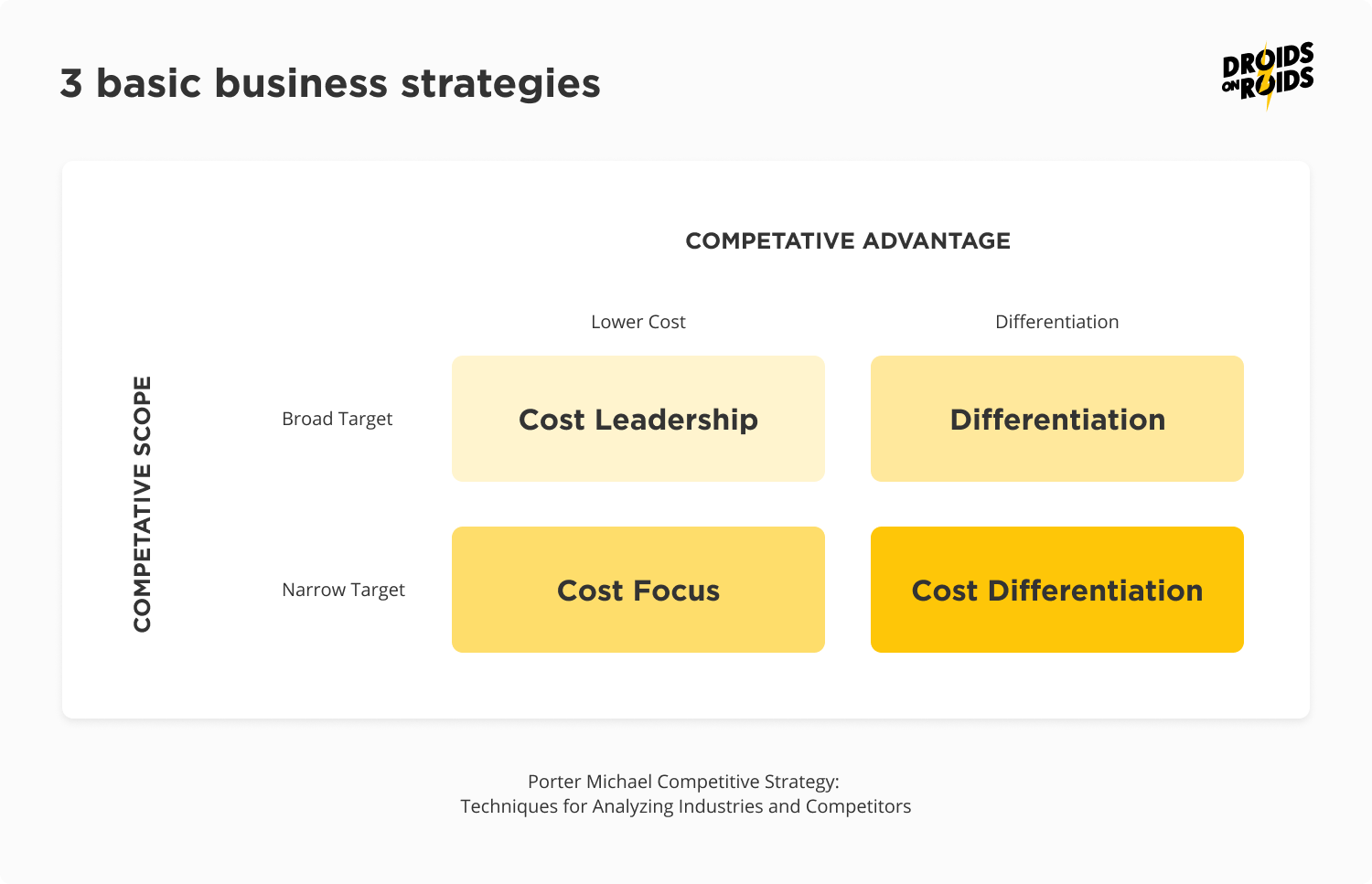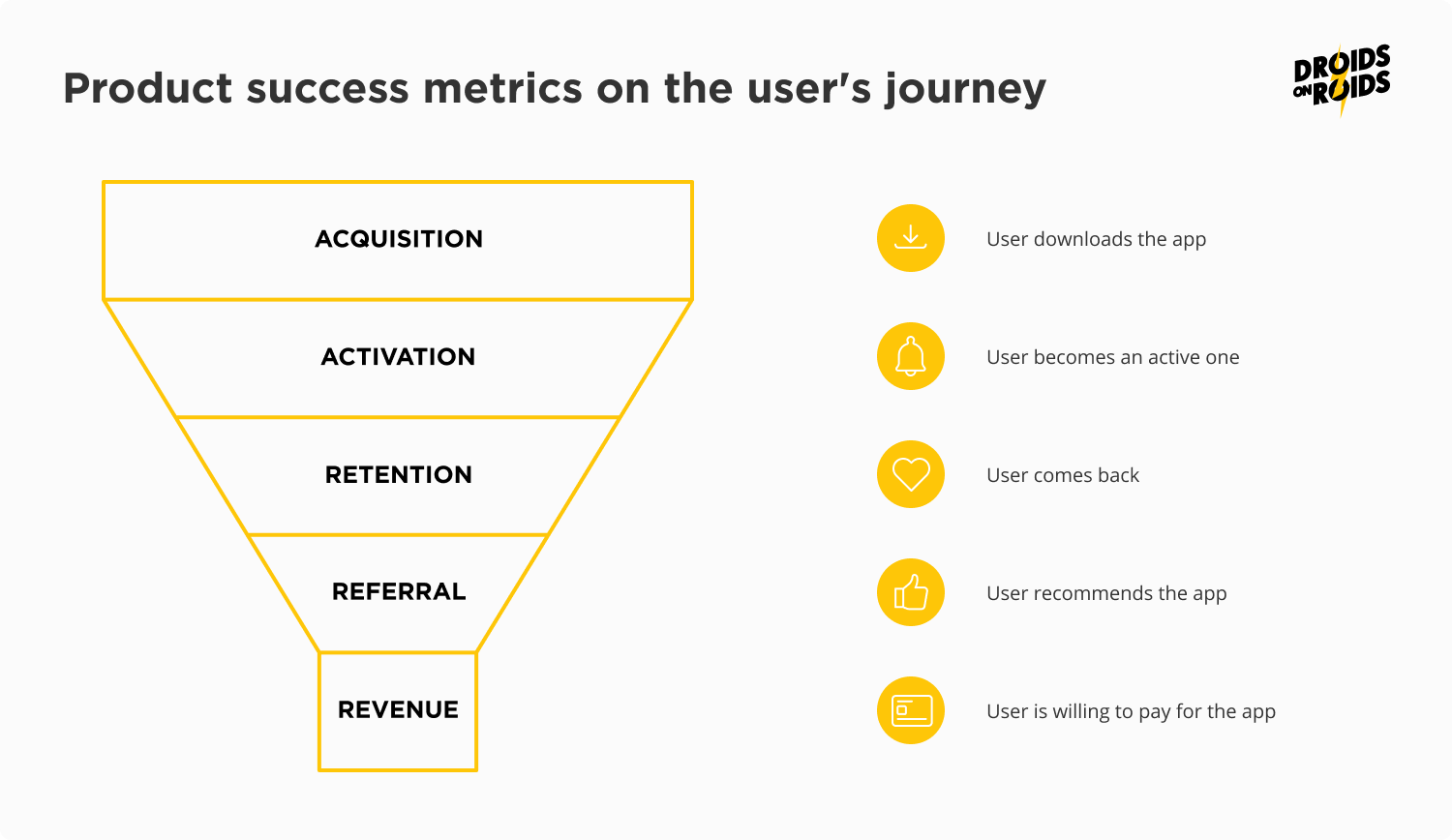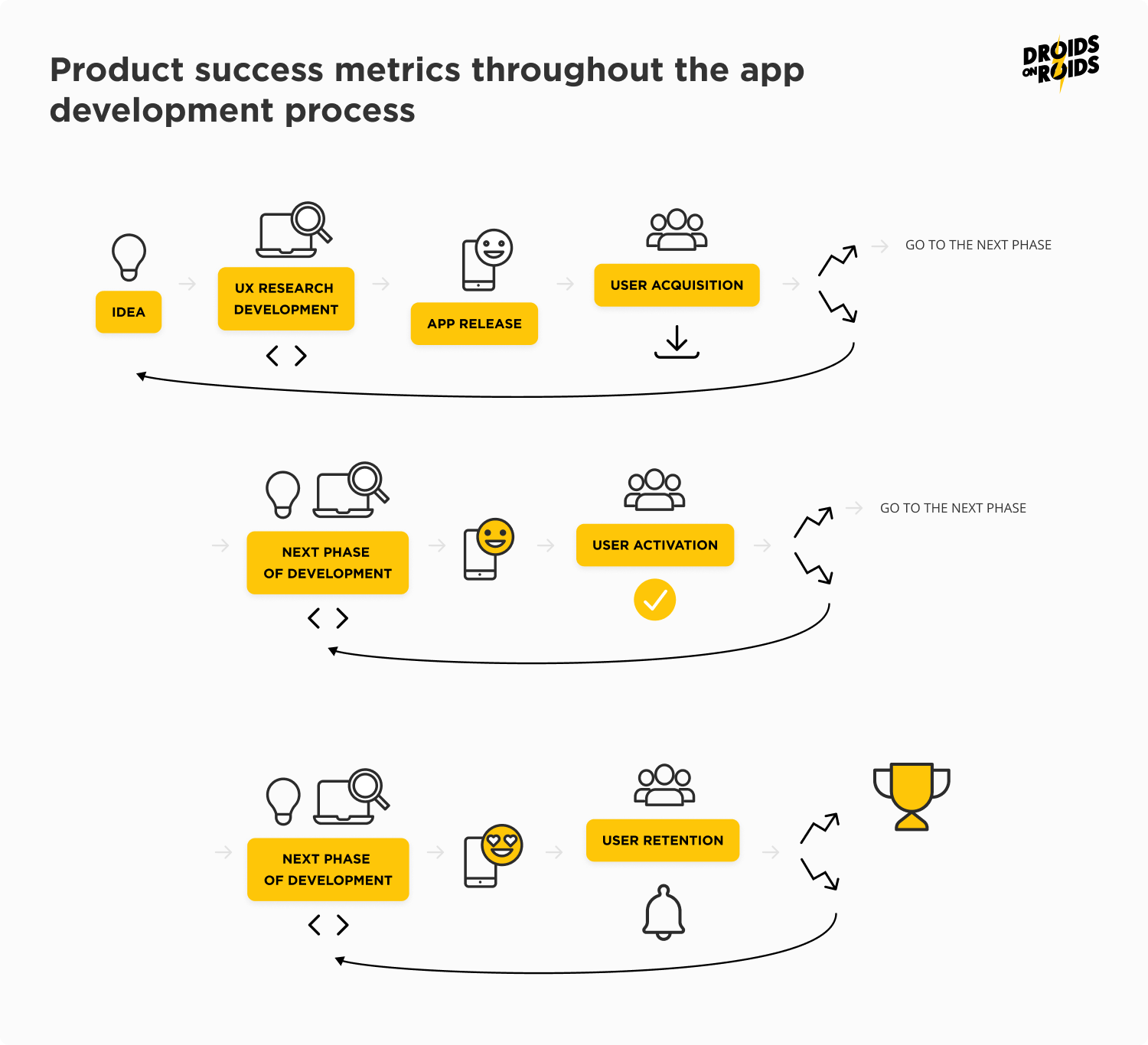Table of contents
Being a Product Owner and creating a successful product is a great adventure. If you are thinking about your own mobile app, you are probably already seeing with your own eyes how your app can make the world a better place and meet user needs.
One of your responsibilities as a Product Owner will be to decide what to measure to know that the strategy you have adopted and the actions you are taking are getting you closer to your goal.
I am a Scrum Master at Droids On Roids and it is a great privilege in my work to be able to help Product Owners build their product successes. Together with our product team, we are constantly looking for optimal solutions to build the best possible, competitive product and increase customer satisfaction. From the beginning of cooperation, we pay attention to product success metrics that allow us to constantly monitor whether the decisions we make have positive effects and are attracting customers.
In this article, I’ll walk you through:
- what product success metrics are,
- why you should measure product success at all,
- and how to choose the right key metrics given your strategy and stage of product development.
What are product success metrics?
Product metrics are indicators of a product’s performance in the marketplace. Put simply, metrics show how a product is performing in the market. Thanks to them, companies and Product Owners receive the appropriate sets of information and answers they need to increase their competitiveness in the market. And last but not least, they help provide an answer to the investor who asks: Product success? Show me the numbers!
The who, when and how of measuring product success
Who?
Tracking business metrics is the job of the person responsible for the product, i.e. the Product Owner or Product Manager. At Droids on Roids, you can use the support of Business Analysts who will help you select metrics for your product, track them, and draw conclusions regarding further steps.
When?
Metrics are important from the very beginning of app development until the end of the product life cycle.
Different metrics are useful at different stages of a product’s life, so first I will introduce you to the key metrics for mobile apps and then I will show you which ones are worth using at which stage.
How?
At Droids on Roids, we use one of the app analytics tools – Firebase – that allows us to track the results of the application in terms of various product metrics. These tools help us determine if our product’s success is increasing or decreasing. There are also other methods for tracking product success metrics, such as collecting data through in-app surveys or conducting qualitative research with users.
Benefits of using product success metrics
Tracking product metrics has many benefits, for example:
- Informed decision-making – during development, you have to make many decisions to increase the value of the product. It is worthwhile for these decisions to be based on data. Metrics can give you valuable insights into your product’s success and help you build products smarter and faster.
- Better prioritization – tracking trends in the product metrics enables you to identify tasks that are worth focusing on at the specific moment because they can bring the highest profit to your business (read also: Top Agile Prioritization Techniques)
- Alignment with Business Goals and Product Strategy – well-chosen product success metrics help us investigate whether the adopted strategy is working or perhaps needs to be modified. They enable you to change your decision faster, which can save you from losing money.
- Increased ROI (return on investment) – results on the effectiveness of your company’s brand strategy can help you understand what approach customers prefer and what does not work.

Align metrics with your business strategy
As I mentioned above, one of the key benefits of tracking metrics is information about whether the Product strategy adopted is working or perhaps needs to be changed as soon as possible. Let’s have a look at product management metrics and a quick look at strategy.
What is a product strategy?
Product strategy – a plan of actions that you take to achieve the chosen product objective, still based on the main vision (read more about digital product goals).
A key element of the chosen Product strategy must be well-selected business metrics. Which strategy will work best for your business and help you achieve a competitive advantage?
3 basic business strategies
The 3 basic business strategies were originally identified by Michael Porter. These strategies are:
- Cost Leadership
- Differentiation
- Focus (Cost Focus and Differentiation Focus)
Cost Leadership – this means a focus on cost reduction. In the case of mobile applications, these could be tools that help companies reduce process costs, digitize documentation, etc. Read also: How Much Does it Cost to Develop an App? New Cost Breakdown.
Differentiation – this is a strategy based on differentiating oneself from the competition. Such a strategy gives a lot of potential for applications. Defining a differentiation strategy requires good research. Our UX team can help you by, for example, analyzing the competition.
Focus – in this strategy, it is important to find your niche. Find your tribe of users and tailor your product to the needs of a selected narrow group.

Take airlines, for example: Low-cost airlines adopt a cost reduction strategy, they focus on a wide target group, and low prices are the main motivator.
Exclusive private airlines adopt a Focus Differentiation strategy – they differentiate themselves in the market for a narrow, selected target group, build loyalty through a unique, distinctive offer, and the cost is no longer so important.
OK, you already know what your core strategy could be, what to measure and how to subsequently validate the direction you have chosen. But what should you focus on in the jungle of the numbers? The answer is… AARRR, as the pirates would say.
AARRR Pirate Metrics – 5 sets of product success metrics for mobile apps
Let’s take a look at the pirate call. AARRR is an acronym for a set of 5 metrics: Acquisition, Activation, Retention, Referral, and Revenue.
Acquisition metrics
Acquisition metrics help you get to know your users, and see how they get to your product. These metrics show you how many users are initially interested in your product and which of your strategies to attract new users works best.
Mobile app: Product success metrics examples:
- Number of new downloads, and new customers over a period of time.
- Download attribution – who is downloading your app, and where they come from.
- CPI: cost per install – the price to acquire a new customer from paid advertisement. This includes sales and marketing costs.
Tip: Ensure you create content designed to attract and provide value to your target customer.
Activation metrics
Activation metrics can show you if your strategy of attracting attention working. Ask yourself how to turn acquired customers into active users.
Mobile app: Product success metrics examples:
- % of downloads that launch the app.
- % of launches that result in signups.
- % of signups that result in being a regular user.
Tip: Success is defined as achieving 80% in these metrics.
Retention metrics
Retention metrics can help you decide how to make users come back, and make users become loyal customers. Find benefits, not just features.
Mobile app: Product success metrics examples:
- DAU: Daily Active users – the total number of people who open and engage with an app on a given day.
- MAU: Monthly Active Users– the total number of people who open and engage with an app in a given month.
- Session per DAU – how often each Daily Active user launches the app.
- User churn – the number of users who decide to stop using the app.
Tip: Invest in interviews with users to get their opinions.
Referral metrics
Referral metrics can help you answer the question of how to get customers to recommend you and increase virality.
Mobile app: Product success metrics examples:
- Referred users – new and unique users that entered referral code at the time of registration.
- Positive reviews – for example, stars on Google Play and App Store.
- Net Promoter Score – on a scale from 0 to 10, an answer to the question “Would you recommend our application?”.
- Social media shares – distributing, posting, or reposting content about your app.
- Customer satisfaction score (CSAT) – the sum of all positive responses, divided by the total responses collected, then multiplied by 100.
Tip: Get to know your users well and see which ones are willing to recommend you.
Revenue metrics
Revenue metrics are the right metrics to show if you are making money on the product, how many paying customers you have and what your future profitability is.
Example metrics depend on the business model adopted for your application:
- Free apps make money from advertising, with corresponding metrics:
- ARPU: average revenue per user
- CAC: customer acquisition cost
- Freemium (free + premium) – make money on subscriptions, using metrics such as:
- % of upgraded users
- % of upgraded users by acquisition source
- Paid apps have different metrics, e.g.:
- Number of downloads
Tip: Set clear business goals.
In the graph below, you can see what sets of metrics will be relevant depending on the stage of the customer journey.

In the beginning, when the user is downloading the app, you can follow the acquisition metrics. Then, if your app is interesting enough, he or she will become an active user, so your activation metrics will grow. The next step is to make users come back and for you to follow the user retention rate. After that, you can focus on referrals and think about revenue.
Let’s combine the knowledge gathered so far about business strategies and product metrics.
If you choose the Cost Leadership strategy, you are targeting a broad unspecified target group, hence your main goal will be user acquisition, activation, and revenue.
When your strategy is based on Differentiation, referrals will also be important to measure.
A strategy aimed at a narrow target group (Focus) will require you to ensure that your selected customers remain loyal, i.e. you will be measuring retention.
You already know the key success metrics for mobile apps but, if you still feel confused, determining what stage of development your product is at can help you.
How to choose product success metrics for the product life stage
Lean Analytics
The Lean Analytics approach identifies 5 phases of product life:
- Empathy phase
- Stickiness phase
- Virality phase
- Revenue phase
- Scale phase
Empathy phase
You are just about to start. You should focus on getting to know your users well, and understand their real needs, similarly making sure your product fits in with those needs. User research and following selected metrics are crucial in this phase. Your main goal is to get the widest possible range of users.
Focus on acquisition and activation metrics. Check if the problem you want to solve is big enough to attract users and what aspects of your marketing strategy are working best.
Stickiness phase
You already have an initial customer base. Your goal now is to make users want to use the app, and stay with you for longer.
You should still measure activation and additionally measure the customer retention rate: daily active users, and monthly active users. See which functions users like, and in which they spend the most time. Ask what they miss in the app.
Virality phase
You already have active users and are looking for new ones. Think about how to keep existing customers and make your app referral-worthy.
Focus on referral metrics, follow reviews, and engage in interviews with real users.
Revenue phase
You have a sizable loyal user base and want to monetize your product. Think about what users will be willing to pay for.
Measure revenue, such as monthly recurring revenue, depending on your business model.
Scale phase
You are ready to conquer new markets. You need to focus again on attracting new customers.
Think about how to increase user acquisition and lower customer acquisition costs.
| Empathy | Stickiness | Virality | Revenue | Scale |
| Acquisition & Activation metrics | Retention metrics | Referrals metrics | Revenue metrics | Acquisition metrics |
| Number of new downloads over a period of time. % of signups that become a regular users. | DAU MAU | Positive reviews | ARPU: average revenue per user. | Number of new downloads over a period of time. |
So which product success metric should you start using in your business right now?
First of all, you should never attempt everything you have in mind for your business strategy. If this is your first step, you should focus on 3-5 key product success metrics. Take into account the strategy you have chosen and the stage at which your product is.
Choose what will help you best track how your product is performing in the market, adjust your strategy, and achieve your goals.
Journey to product’s success
Let’s take a look at a graphic showing the beginning journey through application development. The metrics at each step help you decide whether you are on the right track or whether it is time to turn back and rethink your idea. Metrics can save you time and money, as well as give users the product they really need.
- Step 1: Validate your idea with potential users before starting development. Invest in UX research.
- Step 2: Start development with a version of the application that will carry value for selected users, but will not cost a fortune and long work time.
- Step 3: Follow acquisition metrics and conduct UX research. Check if people like your app and want to use it.
- Step 4: If you hit it right and the idea was an initial success, develop your application further, add new functions, and follow more metrics. If the idea doesn’t work out, rethink the strategy and act in a new way.
This approach will save you time and money and guarantee success.

Measuring digital product success at Droids on Roids
At Droids on Roids, even before development begins, we help clients establish and validate their product vision, adopted strategy, and product goals. Our UX team has a lot of tools for checking the potential of the application (learn more about Product Discovery at Droids On Roids).
As experts in the industry, we know that a different approach and a different set of metrics will be needed by a start-up and a scale-up. We always start development with a Deep Dive phase where, as a Scrum Master, I make sure the entire team understands the goals, strategy, and product metrics. At this stage, we can also decide what Product analysis tool we want to use and what to measure on an ongoing basis.
Established goals and metrics allow the Scrum team to focus on what is the most important, in order to better prioritize the work. In my experience, I’ve witnessed how tracking metrics enables better decisions, from things like deciding to support specific versions to finding easier and faster ways to deliver value.
The entire Scrum team is focused on ensuring that the set success metrics are met. We can continuously check whether the action taken has influenced success and, if not, adjust new actions immediately. In this way, we help you deliver a truly valuable product better, faster, and cheaper.
If you’re looking to bring a product to life that meets and exceeds expectations, Droids on Roids is here to help. Contact us to explore how we can make your product journey a successful one!
Product success metrics: Wrap-up
Well-defined metrics are the Product Owner’s superpower. I hope this article has given you the motivation to think about what a successful product will be for you and how you will measure it.
With the knowledge you gain, you can adjust the basic strategy for your business, determine the life phase of your product, and select the appropriate metrics. The benefits you can get outweigh the effort you put in.
As I hope you remember, well-defined metrics can help you with decision-making based on data, better prioritization, alignment with your product goals and business strategy, and increase your ROI. Of course, you don’t have to do everything on your own. At Droids on Roids, we want to be a partner in creating your unique product and our goal is to help you succeed. Contact us here.
Sources:
- Porter Michael Competitive Strategy: Techniques for Analyzing Industries and Competitors
- Alistair Croll & Benjamin Yoskovitz: Lean Analytics: Use Data to Build a Better Startup Faster





0 responses to "How to Measure Your Digital Product Success | Guide with Examples"